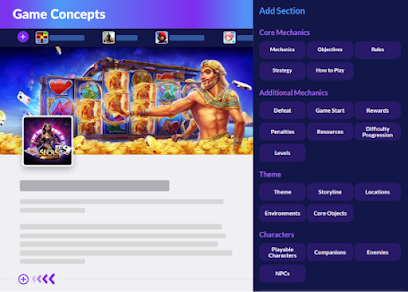The game creation process is a meticulous journey that transforms a concept into an interactive, immersive experience. While game ideas might come naturally, bringing them to life requires a structured approach that ensures clarity, consistency, and quality. One of the most effective ways to organize this process is by developing a Game Design Document (GDD). This article dives into the game creation process and highlights how making a game design document can serve as a guiding force from concept to completion.
1. The Game Creation Process: From Concept to Reality
The game creation process typically follows a series of steps to take a game from an initial idea to a playable product. Here’s a broad look at the essential phases in this journey:
Conceptualization: Every game starts with an idea. This phase involves brainstorming, researching existing games, and identifying unique elements that set the concept apart. Questions like, “What genre will this game fall into?” and “Who is the target audience?” are essential to define the game’s direction.
Planning and Prototyping: Once the concept is solidified, planning begins. This stage involves setting clear goals, timelines, and resources for the game. Simple prototypes or rough sketches often help visualize the core gameplay mechanics and potential challenges.
Design and Development: Here’s where the core game design happens, along with coding and asset creation. Visual elements, sound, story, and gameplay mechanics come together in this stage, turning the initial concept into something playable. The game development team might also create a Game Design Document (GDD) to provide a blueprint for the game’s direction.
Testing and Refinement: After a basic version of the game is developed, playtesting ensures the gameplay is fun, balanced, and functional. Feedback from testing can lead to changes in design, mechanics, or difficulty levels, ultimately enhancing the player’s experience.
Launch and Post-Launch Support: Once the game is refined and polished, it’s ready for launch. However, this is not the end. Post-launch support, including bug fixes, updates, and new content, helps keep players engaged and satisfied with the game.
Understanding these steps and following them closely ensures that the final product meets quality standards and resonates with players.
2. Why a Game Design Document (GDD) Matters
A Game Design Document, or GDD, is a comprehensive document that details every aspect of a game. It's the backbone of the game development process, serving as a single source of truth for all team members. Creating a well-organized and thorough GDD can streamline development and avoid potential confusion.
Here’s how making a game design document benefits the game creation process:
Clear Vision: The GDD offers a clear vision for the game. It defines game mechanics, character details, levels, art style, and more, making it easier for team members to understand the intended direction.
Improved Communication: Development teams often have multiple departments – designers, artists, programmers, and writers – who need to collaborate. The GDD acts as a shared reference point that everyone can access to understand their roles and responsibilities.
Easier Management: A well-crafted GDD helps project managers track progress, set milestones, and allocate resources. By having everything documented, it's easier to keep the project on track and avoid costly delays or misunderstandings.
Future-Proofing the Game: If the game is intended to receive updates or expansions after release, the GDD can help future developers understand the game’s structure and design philosophies, ensuring consistency in any additional content.
3. Essential Elements of a Game Design Document (GDD)
Creating a GDD doesn’t need to be daunting. Here are some key elements that every GDD should contain:
Game Overview: This section introduces the game, its genre, theme, and target audience. It serves as an elevator pitch for what the game is about and what players can expect.
Gameplay Mechanics: This is one of the most detailed parts of the GDD. It outlines how the game is played, covering controls, objectives, and rules. A well-documented gameplay section ensures that everyone on the team understands the player experience being crafted.
Character and Level Design: Character profiles, story arcs, and personality traits are important for narrative games. Additionally, details about each level or stage, including challenges and environments, give designers a foundation to build on.
Visual and Audio Assets: A visual style guide and a breakdown of audio requirements help keep the game's look and feel consistent. Art styles, sound effects, and music are all described here, which assists both the art and sound teams in staying aligned.
Technical Requirements: This includes information about the game engine, platform, and any technical constraints that developers need to consider.
4. Tips for Making a Game Design Document
If you’re new to creating a GDD, here are a few tips to get started:
Start Simple: Begin with a rough outline and gradually expand it. It’s okay if the first draft is not perfect; you can refine it as the game’s development progresses.
Be Specific: Use detailed descriptions wherever possible. Ambiguity can lead to misinterpretations, which can cause unnecessary delays and rework.
Make It Visual: Include sketches, wireframes, or concept art to help visualize the ideas in the document. This can be especially useful for explaining complex gameplay mechanics or level designs.
Review and Update Regularly: Game development is iterative, and things may change along the way. Regularly updating the GDD ensures it remains relevant and valuable throughout the development process.
Conclusion
The game creation process is a complex journey that requires meticulous planning, collaboration, and creativity. A Game Design Document (GDD) is an indispensable tool in this process, providing clarity, structure, and a unified vision for the development team. By making a well-organized GDD, developers can streamline their workflow, enhance communication, and increase the chances of delivering a polished, engaging game to players. Whether you’re working on a simple indie project or a large-scale game, a GDD will guide you every step of the way, from the first concept to the final product.



.jpeg)
